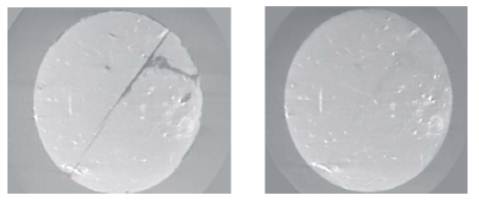Thermo-hydro-mechanical behaviour of clay
In the event of disposal in deep clay, the surrounding clay acts as a natural barrier that encloses the repository and greatly slows the dispersion of any radioactive substances released from the waste packages. Clay has many favourable properties that make it a suitable host: it has plastic behaviour, meaning that any small fractures close up again naturally, it allows very little water to permeate and radioactive substances bind with clay particles. To be able to assess the safety of a repository, these properties must be investigated and analysed deep underground. EIG EURIDICE specifically studies the behaviour of the clay in the excavation-damaged zone around the galleries and the effect of heat on its favourable properties.
Formation of fractures and self-sealing capacity of clay
The excavation of galleries underground inevitably causes fractures in the clay surrounding the excavation area. During construction of the Connecting gallery and the PRACLAY gallery, an extensive research programme was set up to characterise the fracture pattern and analyse its potential impact on the performance of the disposal system. As a result of its high plasticity, clay closes up again over time and the fractures disappear. This is known as "self-sealing". Research in this area has shown that fracturing does not compromise the safety function of the Boom Clay as a natural barrier for geological disposal of radioactive waste.
Characterisation of the fracture pattern in the Connecting gallery
While excavating the Connecting gallery at a depth of 225 metres, the fractures that appeared were measured, both in the side walls and at the working face, in order to characterise the fracture pattern. It was found that fractures formed approximately 6 metres in front of the working face and extended up to 1 metre around the gallery. The CLIPEX project provides detailed information about this research.
 Fractures in the side wall Fractures in the excavation face Schematic fracture pattern
Fractures in the side wall Fractures in the excavation face Schematic fracture pattern
Self-sealing capacity of clay
Due to the plastic behaviour of clay, any fractures formed will close up again naturally. This self-sealing capacity was studied as part of the SELFRAC project. Researchers working in HADES found that boreholes with a diameter of 10 cm closed up completely after a few days. Clay samples were broken open in the above-ground laboratories to track the progress of fracturing. This involved taking scans of the samples. As time went by, the fractures were no longer visible.
 Image of fractured clay core Image of the same clay core after self-sealing
Image of fractured clay core Image of the same clay core after self-sealing
Subjecting clay to heat
High-level radioactive waste produces heat. After a cooling-off period on the surface, this waste will still generate a limited amount of heat after being placed in a disposal gallery, causing the surrounding clay to heat up. Depending on the type of waste, a maximum temperature of about 75°C will be reached at the point of contact between the disposal gallery and the clay some 10-15 years after final disposal. The clay will then cool again and will eventually (after a thousand years) return to the same temperature as before emplacement of the waste.
As part of the ATLAS experiment, a heating element was inserted into the clay through a borehole. By measuring changes in the temperature in other boreholes, scientists were able to study the dissipation of heat through the clay. This made it possible to determine the clay’s thermal conductivity and to calculate what the temperature increase will be at a specific distance from the disposal galleries.
Thermal, hydraulic and mechanical behaviour of clay subjected to heat
To be sure that the clay host rock retains its favourable properties, the impact of this rise in temperature on the clay must be investigated. The increase can have a temporary effect on the clay’s permeability (hydraulic property) and mechanical behaviour. Thermal, hydraulic and mechanical behaviour are interrelated in a highly complex way. We therefore talk about the “THM behaviour” of clay.
The experiments conducted to date indicate that the properties of clay that make it suitable as a natural barrier are not affected in the long term. The aim of the PRACLAY experiment is to confirm and, if necessary, refine existing knowledge on this subject on a large scale. This experiment studies the impact of the THM behaviour of clay on a scale comparable to that of an underground repository. An electrical heating system generates heat comparable to the level that will be produced by high-level waste placed in a disposal gallery after having been cooled on the surface for 60 years. Several sensors are placed around the gallery, measuring not only temperature but also pore water pressure, swelling pressure of the clay, movements of the clay and chemical changes in the pore water.
